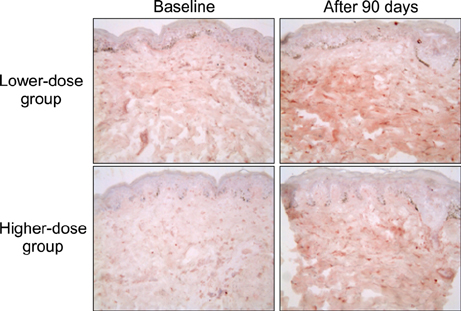Ann Dermatol.
2009 Feb;21(1):6-11. 10.5021/ad.2009.21.1.6.
Dietary Aloe Vera Supplementation Improves Facial Wrinkles and Elasticity and It Increases the Type I Procollagen Gene Expression in Human Skin in vivo
- Affiliations
-
- 1Department of Dermatology, Seoul National University Boramae Hospital, Seoul, Korea.
- 2Department of Dermatology, Seoul National University College of Medicine, Seoul, Korea. jhchung@snu.ac.kr
- 3Laboratory of Cutaneous Aging Research, Clinical Research Institute, Seoul National University Hospital, Seoul, Korea.
- 4Institute of Dermatological Science, Medical Research Center, Seoul National University, Seoul, Korea.
- KMID: 2172058
- DOI: http://doi.org/10.5021/ad.2009.21.1.6
Abstract
-
BACKGROUND: No studies have yet been undertaken to determine the effect of aloe gel on the clinical signs and biochemical changes of aging skin.
OBJECTIVE
We wanted to determine whether dietary aloe vera gel has anti-aging properties on the skin.
METHODS
Thirty healthy female subjects over the age of 45 were recruited and they received 2 different doses (low-dose: 1,200 mg/d, high-dose: 3,600 mg/d) of aloe vera gel supplementation for 90 days. Their baseline status was used as a control. At baseline and at completion of the study, facial wrinkles were measured using a skin replica, and facial elasticity was measured by an in vivo suction skin elasticity meter. Skin samples were taken before and after aloe intake to compare the type I procollagen and matrix metalloproteinase 1 (MMP-1) mRNA levels by performing real-time RT-PCR.
RESULTS
After aloe gel intake, the facial wrinkles improved significantly (p<0.05) in both groups, and facial elasticity improved in the lower-dose group. In the photoprotected skin, the type I procollagen mRNA levels were increased in both groups, albeit without significance; the MMP-1 mRNA levels were significantly decreased in the higher-dose group. Type I procollagen immunostaining was substantially increased throughout the dermis in both groups.
CONCLUSION
Aloe gel significantly improves wrinkles and elasticity in photoaged human skin, with an increase in collagen production in the photoprotected skin and a decrease in the collagen- degrading MMP-1 gene expression. However, no dose- response relationship was found between the low-dose and high-dose groups.
Keyword
MeSH Terms
Figure
Reference
-
1. Varani J, Warner RL, Gharaee-Kermani M, Phan SH, Kang S, Chung JH, et al. Vitamin A antagonizes decreased cell growth and elevated collagen-degrading matrix metalloproteinases and stimulates collagen accumulation in naturally aged human skin. J Invest Dermatol. 2000. 114:480–486.
Article2. Fisher GJ, Wang ZQ, Datta SC, Varani J, Kang S, Voorhees JJ. Pathophysiology of premature skin aging induced by ultraviolet light. N Engl J Med. 1997. 337:1419–1428.
Article3. Shelton RM. Aloe vera. Its chemical and therapeutic properties. Int J Dermatol. 1991. 30:679–683.4. Klein AD, Penneys NS. Aloe vera. J Am Acad Dermatol. 1988. 18:714–720.
Article5. Reynolds T, Dweck AC. Aloe vera leaf gel: a review update. J Ethnopharmacol. 1999. 68:3–37.
Article6. Natow AJ. Aloe vera, fiction or fact. Cutis. 1986. 37:106. 108.7. Strickland FM, Darvill A, Albersheim P, Eberhard S, Pauly M, Pelley RP. Inhibition of UV-induced immune suppression and interleukin-10 production by plant oligosaccharides and polysaccharides. Photochem Photobiol. 1999. 69:141–147.
Article8. Byeon SW, Pelley RP, Ullrich SE, Waller TA, Bucana CD, Strickland FM. Aloe barbadensis extracts reduce the production of interleukin-10 after exposure to ultraviolet radiation. J Invest Dermatol. 1998. 110:811–817.
Article9. Davis RH, Rosenthal KY, Cesario LR, Rouw GA. Processed Aloe vera administered topically inhibits inflammation. J Am Podiatr Med Assoc. 1989. 79:395–397.
Article10. Thompson JE. Topical use of aloe vera derived allantoin gel in otolaryngology. Ear Nose Throat J. 1991. 70:119.11. Davis RH, Donato JJ, Hartman GM, Haas RC. Anti-inflammatory and wound healing activity of a growth substance in Aloe vera. J Am Podiatr Med Assoc. 1994. 84:77–81.
Article12. Chithra P, Sajithlal GB, Chandrakasan G. Influence of Aloe vera on the glycosaminoglycans in the matrix of healing dermal wounds in rats. J Ethnopharmacol. 1998. 59:179–186.
Article13. Thomas DR, Goode PS, LaMaster K, Tennyson T. Acemannan hydrogel dressing versus saline dressing for pressure ulcers. A randomized, controlled trial. Adv Wound Care. 1998. 11:273–276.14. Schmidt JM, Greenspoon JS. Aloe vera dermal wound gel is associated with a delay in wound healing. Obstet Gynecol. 1991. 78:115–117.15. Yaron A. Characterization of Aloe vera gel before and after autodegradation, and stabilization of the natural fresh gel. Phytother Res. 1993. 7:S11–S13.16. Livak KJ, Schmittgen TD. Analysis of relative gene expression data using real-time quantitative PCR and the 2(-Delta Delta C(T)) Method. Methods. 2001. 25:402–408.
Article17. Chithra P, Sajithlal GB, Chandrakasan G. Influence of aloe vera on the healing of dermal wounds in diabetic rats. J Ethnopharmacol. 1998. 59:195–201.
Article18. Chithra P, Sajithlal GB, Chandrakasan G. Influence of Aloe vera on collagen characteristics in healing dermal wounds in rats. Mol Cell Biochem. 1998. 181:71–76.19. Strickland FM, Pelley RP, Kripke ML. Prevention of ultraviolet radiation-induced suppression of contact and delayed hypersensitivity by Aloe barbadensis gel extract. J Invest Dermatol. 1994. 102:197–204.
Article20. Strickland FM. Immune regulation by polysaccharides: implications for skin cancer. J Photochem Photobiol B. 2001. 63:132–140.
Article21. Lindblad WJ, Thul J. Sustained increase in collagen biosynthesis in acemannan impregnated PVA implants in the rat [abstract]. Wound Repair Regen. 1994. 2:84.22. Sabeh F, Wright T, Norton SJ. Isozymes of superoxide dismutase from Aloe vera. Enzyme Protein. 1996. 49:212–221.23. Rabe C, Musch A, Schirmacher P, Kruis W, Hoffmann R. Acute hepatitis induced by an Aloe vera preparation: a case report. World J Gastroenterol. 2005. 11:303–304.
Article24. Kanat O, Ozet A, Ataergin S. Aloe vera-induced acute toxic hepatitis in a healthy young man. Eur J Intern Med. 2006. 17:589.
Article25. Bottenberg MM, Wall GC, Harvey RL, Habib S. Oral aloe vera-induced hepatitis. Ann Pharmacother. 2007. 41:1740–1743.
Article
- Full Text Links
- Actions
-
Cited
- CITED
-
- Close
- Share
- Similar articles
-
- The Effect of Hydroxyproline on the Improvement of Facial Wrinkles
- Facial Rejuvenation with High-intensity Focused Ultrasonography
- A Study on Anti-irritant Effect of Aloe Vera Gel Against the Irritation of Sodium Lauryl Sulfate
- Expression of type IV collagen and laminin genes by skin fibroblasts in culture
- A Clinical Study of Facial Wrinkles Affected by Facial Expression Muscles Treated with Botulinum Toxin(Botox(R))




